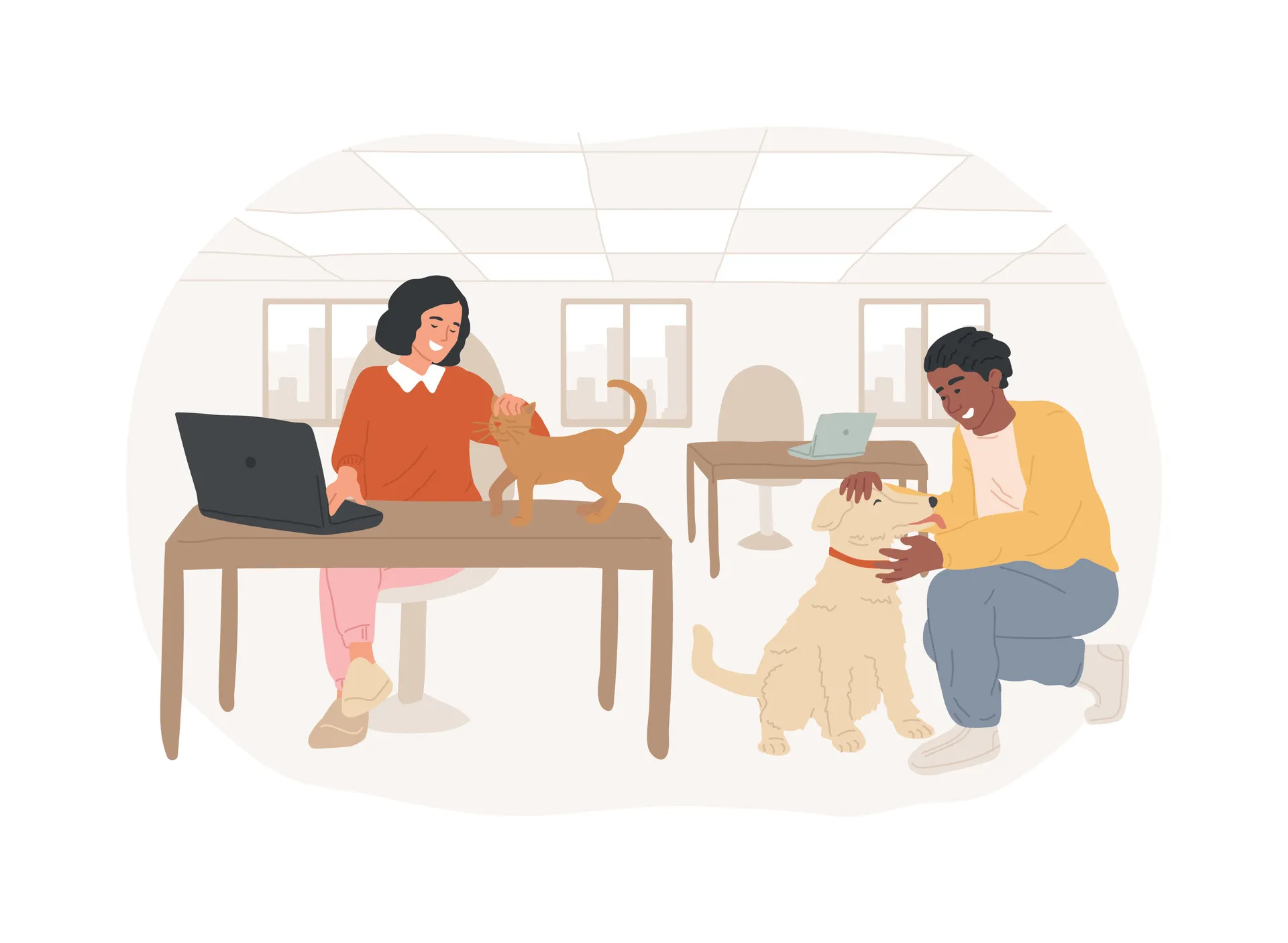Introduction
The modern workplace is evolving, and the concept of a pet-friendly office is gaining traction. As more companies recognize the benefits of allowing pets in the workplace, property developers are presented with a unique opportunity to cater to this trend. Designing pet-friendly office buildings not only enhances employee satisfaction and productivity but also attracts a wider range of tenants. This guide explores the essential considerations and best practices for creating pet-friendly office spaces.
Understanding the Benefits of Pet-Friendly Offices
1. Boosting Employee Morale
Allowing pets in the workplace can significantly enhance employee morale. Studies show that having pets around can reduce stress levels, promote relaxation, and create a more enjoyable work environment. When employees can bring their furry friends to work, they often feel happier and more engaged.
2. Attracting Talent
In today’s competitive job market, companies are seeking innovative ways to attract top talent. A pet-friendly policy can be a unique selling point that differentiates a business from its competitors. Job seekers, especially millennials and Gen Z, often prioritize workplaces that embrace a pet-friendly culture.
3. Enhancing Team Collaboration
Pets can act as social catalysts, encouraging interaction among employees. In a pet-friendly office, employees may engage more with one another, fostering collaboration and camaraderie. This can lead to increased teamwork and improved workplace dynamics.
Key Design Considerations for Pet-Friendly Offices
1. Space Planning
Creating Designated Pet Areas
When designing a pet-friendly office, it’s essential to allocate specific areas for pets. This could include:
- Pet Relaxation Zones: Comfortable spaces where pets can rest and play.
- Pet-Relief Areas: Designated outdoor spaces with appropriate surfaces for pets to relieve themselves.
- Pet-Free Zones: Certain areas, such as meeting rooms or kitchens, may need to be off-limits to pets for hygiene and safety reasons.
Open Floor Plans
Consider incorporating open floor plans that allow for flexibility in pet movement. This can help create a more dynamic environment where pets can roam freely while employees maintain visibility and interaction.
2. Choosing Pet-Friendly Materials
Durable Flooring Options
Select flooring materials that can withstand the wear and tear caused by pets. Options include:
- Vinyl Flooring: Durable, easy to clean, and resistant to scratches.
- Tile: Water-resistant and simple to maintain, making it ideal for pet-friendly spaces.
- Carpet Tiles: Replaceable sections can be used in areas where pets are permitted, providing comfort while allowing for easy maintenance.
Furniture Selection
Opt for furniture that is durable and easy to clean. Consider:
- Leather or Microfiber Upholstery: These materials are resistant to stains and easy to wipe down.
- Pet-Friendly Fabrics: Choose fabrics that are less likely to snag or trap pet hair.
3. Incorporating Green Spaces
Outdoor Areas for Pets
Creating outdoor green spaces is essential for pet-friendly offices. These areas can include:
- Dog Parks: Secure areas where pets can play off-leash.
- Walking Paths: Safe and well-maintained paths for employees to take their pets on walks.
- Gardens: Pet-friendly gardens that can serve as relaxation spots for employees and their pets.
Indoor Plants
Consider incorporating pet-safe indoor plants that improve air quality while ensuring the safety of furry companions. Examples include spider plants, Boston ferns, and bamboo palms.
Implementing Pet Policies
1. Establishing Clear Guidelines
To ensure a smooth integration of pets in the workplace, it’s crucial to establish clear policies. Consider including:
- Pet Registration: Require employees to register their pets, providing details such as breed, size, and vaccination status.
- Behavior Guidelines: Outline acceptable pet behavior in the office and consequences for disruptive behavior.
- Health and Safety Protocols: Ensure that pets are up-to-date on vaccinations and free from parasites to maintain a healthy environment.
2. Creating a Pet Committee
Establishing a pet committee can help manage and enforce pet policies. This committee can:
- Address concerns from employees regarding pets in the office.
- Organize pet-related events, such as “bring your pet to work” days or pet wellness seminars.
- Provide resources and information about pet care to employees.
Best Practices for Property Developers
1. Collaborate with Tenants
Engaging with potential tenants during the design phase can provide valuable insights into their needs and preferences regarding pet-friendly spaces. Conduct surveys or hold focus groups to gather feedback on design elements and policies.
2. Stay Updated on Regulations
Familiarize yourself with local regulations regarding pets in commercial spaces. This may include zoning laws, health regulations, and liability concerns. Staying informed will help ensure that your property complies with all legal requirements.
3. Promote Pet-Friendly Features
Once your pet-friendly office building is completed, it’s essential to market these features effectively. Use social media, real estate listings, and promotional materials to highlight the benefits of a pet-friendly workplace. Showcasing testimonials from satisfied tenants can further enhance your property’s appeal.
Conclusion
Designing pet-friendly office buildings presents a unique opportunity for property developers to create spaces that cater to the evolving needs of modern workplaces. By considering employee well-being, choosing suitable materials, and establishing clear pet policies, developers can create environments that foster happiness, productivity, and collaboration. As the demand for pet-friendly offices continues to grow, embracing this trend can set your properties apart and attract a diverse range of tenants.
Designing pet-friendly office buildings has become a popular trend for property developers aiming to attract modern tenants. With more employees enjoying pet-friendly workplaces, developers are considering amenities that accommodate pets, like outdoor play areas, pet-washing stations, and designated quiet spaces for pets and their owners. For developers in Mankato, MN, this trend also influences choices in other types of properties. For example, those interested in ranch land for sale in Mankato, MN, or farm land for sale in Mankato, MN, can explore pet-friendly designs that attract buyers seeking multi-functional spaces for both business and leisure. Pet-friendly office concepts also impact the appeal of business buildings for sale in Mankato, MN, where accommodating tenants who bring pets to work could be a significant draw. Thoughtfully designed pet-friendly office spaces can provide a unique selling point, ensuring these properties remain competitive and attractive in the market.
FAQs
1. What are the benefits of pet-friendly offices?
Pet-friendly offices can boost employee morale, attract talent, and enhance team collaboration by creating a more enjoyable and engaging work environment.
2. How can I make my office building pet-friendly?
To make your office building pet-friendly, allocate designated pet areas, choose durable materials, incorporate green spaces, and establish clear pet policies.
3. Are there any health concerns with pets in the workplace?
Yes, health concerns include allergies and the potential for disease transmission. Implementing health and safety protocols, such as vaccination requirements, can help mitigate these risks.
4. What flooring is best for pet-friendly offices?
Durable flooring options like vinyl, tile, or carpet tiles are ideal for pet-friendly offices as they withstand wear and are easy to clean.
5. How can I promote my pet-friendly office building?
Promote your pet-friendly office building through social media, real estate listings, and testimonials from satisfied tenants, highlighting the benefits of a pet-friendly workplace.

